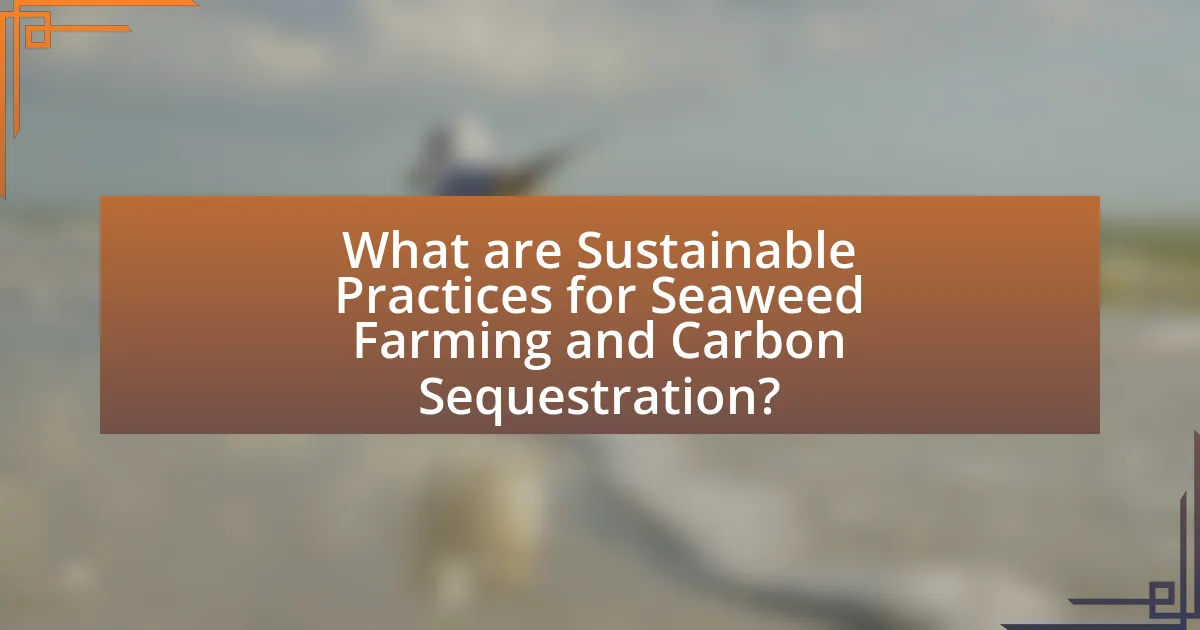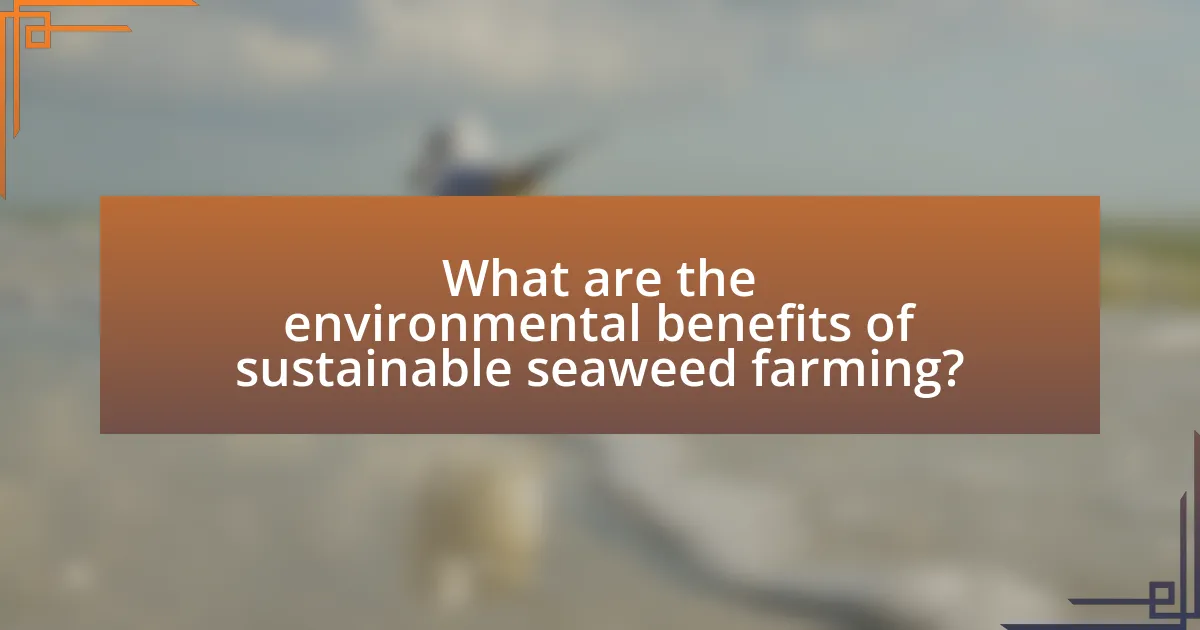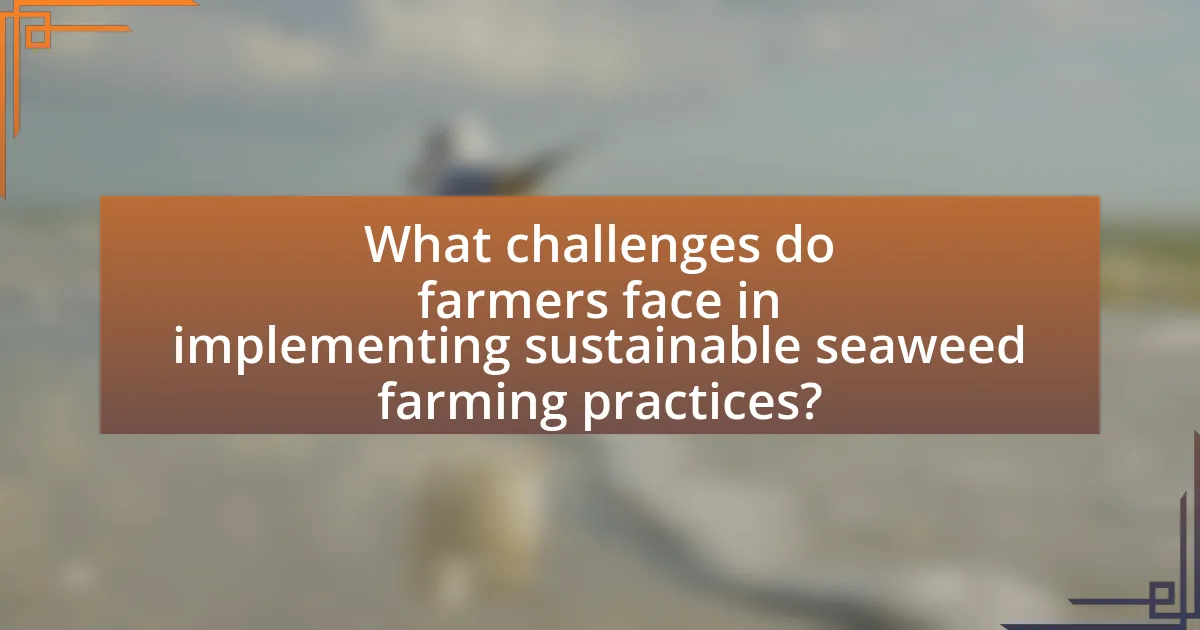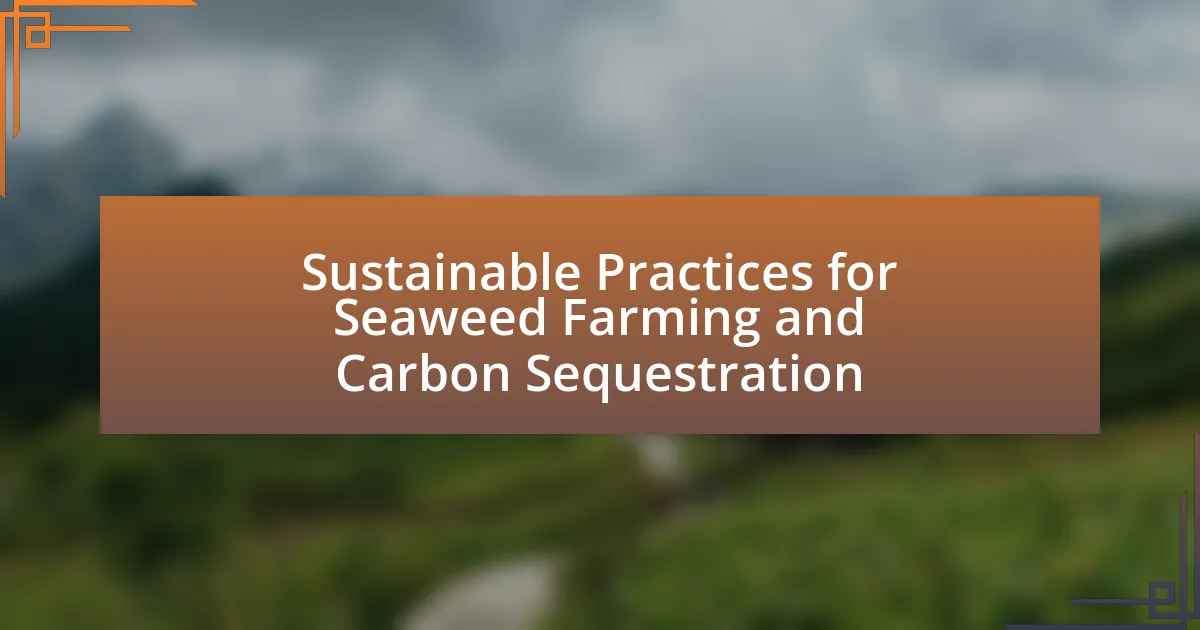Sustainable practices for seaweed farming and carbon sequestration are essential for promoting environmental health and mitigating climate change. Key methods include integrated multi-trophic aquaculture (IMTA), selective breeding, and organic farming techniques, which enhance ecosystem productivity, improve biodiversity, and reduce chemical inputs. These practices not only support the growth of seaweed but also significantly contribute to carbon sequestration, with potential annual CO2 capture reaching up to 1.1 billion tons. The article explores the environmental and economic benefits of sustainable seaweed farming, the challenges faced by farmers, and the role of technology and policy in supporting these practices.

What are Sustainable Practices for Seaweed Farming and Carbon Sequestration?
Sustainable practices for seaweed farming and carbon sequestration include integrated multi-trophic aquaculture (IMTA), selective breeding of seaweed species, and the use of organic farming techniques. IMTA enhances ecosystem health by cultivating seaweed alongside other marine organisms, which helps to balance nutrient levels and improve overall productivity. Selective breeding focuses on developing seaweed strains that grow faster and are more resilient, thereby increasing yields and reducing the need for chemical inputs. Organic farming techniques, such as avoiding synthetic fertilizers and pesticides, promote a healthier marine environment and contribute to carbon sequestration by allowing seaweed to absorb carbon dioxide during photosynthesis. These practices collectively support sustainable seaweed farming while effectively capturing carbon from the atmosphere.
How do sustainable practices impact seaweed farming?
Sustainable practices significantly enhance seaweed farming by promoting environmental health and economic viability. These practices, such as integrated multi-trophic aquaculture (IMTA) and organic farming methods, reduce nutrient pollution and improve biodiversity in marine ecosystems. For instance, IMTA allows for the cultivation of seaweed alongside fish and shellfish, which can utilize the waste produced by these animals, thereby creating a balanced ecosystem that minimizes waste and maximizes productivity. Research indicates that sustainable seaweed farming can sequester carbon effectively, with studies showing that seaweed absorbs carbon dioxide at rates comparable to terrestrial forests, thus contributing to climate change mitigation.
What methods are considered sustainable in seaweed farming?
Sustainable methods in seaweed farming include integrated multi-trophic aquaculture (IMTA), which combines seaweed cultivation with other marine species to enhance ecosystem health. IMTA promotes nutrient recycling, as seaweed absorbs excess nutrients from fish farming, reducing water pollution. Additionally, using low-impact harvesting techniques minimizes damage to marine habitats, while selecting native species for cultivation supports biodiversity. Research indicates that these practices can enhance carbon sequestration, with seaweed farms potentially capturing significant amounts of CO2, contributing to climate change mitigation.
How do these methods contribute to carbon sequestration?
Sustainable practices in seaweed farming significantly contribute to carbon sequestration by enhancing the ocean’s ability to absorb and store carbon dioxide. Seaweed absorbs CO2 during photosynthesis, converting it into biomass, which can sequester carbon for extended periods when the seaweed is harvested and processed into products like biofuels or fertilizers. Research indicates that seaweed farming can sequester up to 1.1 billion tons of CO2 annually, demonstrating its potential as a climate change mitigation strategy.
Why is carbon sequestration important in the context of seaweed farming?
Carbon sequestration is important in the context of seaweed farming because it significantly reduces atmospheric carbon dioxide levels, contributing to climate change mitigation. Seaweed absorbs carbon dioxide during photosynthesis, storing carbon in its biomass and the ocean, which can help offset greenhouse gas emissions. Research indicates that seaweed farming can sequester up to 1.1 billion tons of carbon dioxide annually, making it a viable solution for enhancing carbon sinks and promoting sustainable marine ecosystems.
What role does seaweed play in the carbon cycle?
Seaweed plays a significant role in the carbon cycle by absorbing carbon dioxide during photosynthesis, which contributes to carbon sequestration in marine ecosystems. Through this process, seaweed captures atmospheric CO2 and converts it into organic matter, effectively reducing greenhouse gas concentrations. Studies indicate that large-scale seaweed cultivation can sequester substantial amounts of carbon; for instance, it is estimated that seaweed farming could potentially remove up to 1 billion tons of CO2 annually, thereby mitigating climate change impacts.
How does seaweed farming compare to other carbon sequestration methods?
Seaweed farming is a highly effective carbon sequestration method, comparable to terrestrial options like afforestation and soil carbon storage. Research indicates that seaweed can sequester up to 1.1 billion tons of carbon dioxide annually, significantly contributing to climate change mitigation. In contrast, afforestation can sequester approximately 1.1 to 2.6 billion tons of CO2 per year, depending on the scale and type of trees planted. Additionally, seaweed farming has the advantage of not requiring arable land, thus avoiding competition with food production, while terrestrial methods often face land-use conflicts. Studies, such as those published in “Nature Climate Change,” highlight that seaweed’s rapid growth rates and ability to thrive in marine environments make it a promising alternative for carbon capture, reinforcing its role in sustainable practices for carbon sequestration.

What are the environmental benefits of sustainable seaweed farming?
Sustainable seaweed farming provides significant environmental benefits, including carbon sequestration, habitat creation, and water quality improvement. Seaweed absorbs carbon dioxide during photosynthesis, contributing to the reduction of greenhouse gases in the atmosphere; studies indicate that seaweed can sequester up to 1.1 billion tons of carbon annually. Additionally, sustainable seaweed farms create habitats for marine life, enhancing biodiversity in coastal ecosystems. Furthermore, seaweed cultivation can improve water quality by absorbing excess nutrients, such as nitrogen and phosphorus, which helps mitigate issues like eutrophication. These benefits collectively support healthier marine environments and contribute to climate change mitigation.
How does sustainable seaweed farming promote biodiversity?
Sustainable seaweed farming promotes biodiversity by creating habitats that support various marine species. The cultivation of seaweed provides shelter and food for fish, invertebrates, and other marine organisms, enhancing local ecosystems. Research indicates that seaweed farms can increase species richness and abundance, as they serve as artificial reefs that attract diverse marine life. For instance, a study published in the journal “Marine Ecology Progress Series” found that seaweed farms can host up to 50% more fish species compared to barren seabeds, demonstrating their role in fostering marine biodiversity.
What species benefit from sustainable seaweed farming practices?
Sustainable seaweed farming practices benefit various marine species, including fish, invertebrates, and other aquatic organisms. These practices create habitats that enhance biodiversity, providing shelter and food sources for species such as juvenile fish, crabs, and mollusks. Research indicates that seaweed farms can increase local fish populations by up to 30%, as they serve as nurseries for young fish and attract a diverse range of marine life. Additionally, sustainable seaweed farming contributes to improved water quality, which further supports the health of surrounding ecosystems.
How does biodiversity contribute to ecosystem resilience?
Biodiversity enhances ecosystem resilience by increasing the variety of species and genetic diversity within an ecosystem, which allows for greater adaptability to environmental changes and disturbances. Diverse ecosystems can better withstand stressors such as climate change, disease, and invasive species because different species fulfill various ecological roles, ensuring that essential functions are maintained even when some species are affected. For instance, studies have shown that ecosystems with higher biodiversity are more productive and stable, as they can utilize resources more efficiently and recover more quickly from disruptions. This is evidenced by research indicating that diverse marine ecosystems, such as coral reefs, exhibit greater resilience to bleaching events compared to less diverse systems, highlighting the critical role of biodiversity in maintaining ecosystem health and stability.
What are the economic advantages of sustainable seaweed farming?
Sustainable seaweed farming offers significant economic advantages, including job creation, increased income for coastal communities, and the potential for high-value products. This farming method can generate employment opportunities in harvesting, processing, and distribution, contributing to local economies. For instance, a study by the Food and Agriculture Organization (FAO) reported that seaweed farming can provide livelihoods for over 10 million people globally, particularly in developing countries. Additionally, sustainable practices can lead to higher market prices for seaweed products, such as food, cosmetics, and biofuels, enhancing profitability. The global seaweed market was valued at approximately $14 billion in 2020 and is projected to grow, driven by increasing demand for sustainable and health-oriented products.
How can sustainable practices enhance profitability for farmers?
Sustainable practices can enhance profitability for farmers by reducing costs and increasing market access. For instance, implementing organic farming methods can lower input costs associated with synthetic fertilizers and pesticides, leading to higher profit margins. Additionally, sustainable practices often attract premium prices in markets that prioritize environmentally friendly products, such as organic seaweed, which has seen a 20% increase in demand over the past five years. Furthermore, practices like crop rotation and intercropping can improve soil health and yield resilience, ultimately leading to more consistent production and revenue.
What markets are emerging for sustainably farmed seaweed products?
Emerging markets for sustainably farmed seaweed products include food and beverage, cosmetics, pharmaceuticals, and bioplastics. The food and beverage sector is increasingly incorporating seaweed as a health supplement and ingredient due to its nutritional benefits, with the global seaweed market projected to reach $19.5 billion by 2024. In cosmetics, seaweed extracts are valued for their moisturizing and anti-aging properties, driving demand in the skincare industry. The pharmaceutical market is exploring seaweed for its bioactive compounds, which have potential health benefits, including anti-inflammatory and antioxidant effects. Additionally, the bioplastics market is leveraging seaweed as a sustainable alternative to petroleum-based plastics, aligning with global sustainability goals.

What challenges do farmers face in implementing sustainable seaweed farming practices?
Farmers face several challenges in implementing sustainable seaweed farming practices, including environmental factors, economic constraints, and regulatory hurdles. Environmental factors such as water quality, temperature fluctuations, and competition from other marine species can adversely affect seaweed growth and yield. Economic constraints include high initial investment costs for infrastructure and technology, as well as ongoing operational expenses that may not be offset by immediate returns. Regulatory hurdles often involve complex permitting processes and compliance with environmental regulations, which can vary significantly by region. These challenges collectively hinder the widespread adoption of sustainable seaweed farming practices.
What are the common obstacles to adopting sustainable methods?
Common obstacles to adopting sustainable methods in seaweed farming and carbon sequestration include high initial costs, lack of technical knowledge, regulatory challenges, and market access issues. High initial costs deter farmers from investing in sustainable practices, as they often require advanced technology and infrastructure. Additionally, a lack of technical knowledge among farmers can hinder the implementation of effective sustainable methods, as they may not be aware of best practices or available resources. Regulatory challenges arise from complex permitting processes and inconsistent policies that can create uncertainty for farmers. Lastly, limited market access for sustainably farmed seaweed can reduce economic incentives, making it difficult for farmers to justify the transition to sustainable practices.
How can farmers overcome these challenges?
Farmers can overcome challenges in sustainable seaweed farming and carbon sequestration by adopting integrated multi-trophic aquaculture (IMTA) systems. IMTA allows farmers to cultivate seaweed alongside other marine species, enhancing nutrient cycling and reducing waste. Research indicates that IMTA can increase overall productivity by up to 30% while improving environmental sustainability (Troell et al., 2009, “Ecological Engineering”). Additionally, farmers can implement advanced monitoring technologies to optimize growth conditions and reduce resource use, leading to more efficient farming practices. These strategies not only address ecological challenges but also enhance economic viability, making seaweed farming more resilient and sustainable.
What role do policies play in supporting sustainable seaweed farming?
Policies play a crucial role in supporting sustainable seaweed farming by establishing regulatory frameworks that promote environmentally responsible practices. These policies can include guidelines for sustainable harvesting, incentives for eco-friendly farming techniques, and measures to protect marine ecosystems. For instance, the implementation of marine spatial planning can help designate areas for seaweed farming that minimize conflicts with other marine activities and protect biodiversity. Additionally, financial support mechanisms, such as grants or subsidies for sustainable practices, encourage farmers to adopt methods that reduce environmental impact. Evidence from countries like Norway and Japan shows that effective policy frameworks have led to increased seaweed production while maintaining ecological balance, demonstrating the positive impact of well-structured policies on sustainable seaweed farming.
How can technology aid in sustainable seaweed farming?
Technology can aid in sustainable seaweed farming by enhancing monitoring, optimizing growth conditions, and improving harvesting efficiency. Advanced sensors and satellite imagery allow farmers to monitor environmental conditions such as water temperature, salinity, and nutrient levels in real-time, which helps in making informed decisions that promote healthy seaweed growth. For instance, the use of drones equipped with multispectral cameras can assess seaweed health and biomass, enabling targeted interventions. Additionally, automated systems for nutrient delivery and water quality management can optimize growth conditions, leading to higher yields with lower resource inputs. Research indicates that integrating these technologies can increase productivity by up to 30%, while also reducing the environmental impact associated with traditional farming methods.
What innovations are currently being used in seaweed farming?
Innovations currently being used in seaweed farming include integrated multi-trophic aquaculture (IMTA), advanced cultivation techniques, and biotechnological advancements. IMTA combines the farming of seaweed with other marine species, such as fish and shellfish, to create a balanced ecosystem that enhances productivity and reduces waste. Advanced cultivation techniques, such as using floating farms and automated harvesting systems, improve efficiency and reduce labor costs. Biotechnological advancements, including selective breeding and genetic modification, aim to enhance growth rates and resilience of seaweed species. These innovations contribute to sustainable practices in seaweed farming and support carbon sequestration efforts by increasing biomass production and promoting ecosystem health.
How do these technologies improve sustainability and carbon sequestration?
Technologies in sustainable seaweed farming enhance sustainability and carbon sequestration by optimizing growth conditions and reducing environmental impacts. These technologies include precision farming techniques, which utilize sensors and data analytics to monitor water quality and nutrient levels, ensuring optimal growth while minimizing resource use. For instance, studies have shown that seaweed can absorb significant amounts of carbon dioxide, with estimates suggesting that large-scale seaweed cultivation could sequester up to 1 billion tons of CO2 annually. Additionally, the integration of seaweed farming with aquaculture can lead to improved nutrient cycling, reducing the need for chemical fertilizers and further decreasing greenhouse gas emissions.
What best practices should be followed for effective sustainable seaweed farming?
Effective sustainable seaweed farming should prioritize practices such as site selection, biodiversity maintenance, and responsible harvesting techniques. Site selection involves choosing locations with optimal water quality and flow, which enhances growth and minimizes environmental impact. Maintaining biodiversity is crucial, as diverse ecosystems support resilience against diseases and climate change, while also providing habitat for marine life. Responsible harvesting techniques, including selective harvesting and allowing for regrowth, ensure that seaweed populations remain sustainable over time. Research indicates that these practices not only support the health of marine ecosystems but also enhance carbon sequestration, contributing to climate change mitigation.
How can farmers ensure their practices are environmentally friendly?
Farmers can ensure their practices are environmentally friendly by adopting sustainable farming techniques such as integrated pest management, crop rotation, and organic farming. These methods reduce chemical inputs, enhance soil health, and promote biodiversity. For instance, integrated pest management minimizes pesticide use by utilizing natural predators, which has been shown to decrease chemical runoff into waterways, thereby protecting aquatic ecosystems. Additionally, crop rotation improves soil fertility and reduces erosion, contributing to long-term sustainability. Research indicates that organic farming can lead to a 30% increase in soil organic matter, which is crucial for carbon sequestration, thereby mitigating climate change impacts.
What resources are available for farmers looking to adopt sustainable practices?
Farmers looking to adopt sustainable practices can access various resources, including government programs, educational materials, and financial assistance. The USDA offers grants and technical assistance through programs like the Environmental Quality Incentives Program (EQIP), which supports sustainable agricultural practices. Additionally, organizations such as the Sustainable Agriculture Research and Education (SARE) provide research-based resources and funding for innovative practices. Research from the National Oceanic and Atmospheric Administration (NOAA) highlights the role of seaweed farming in carbon sequestration, emphasizing its potential benefits for sustainable farming. These resources collectively support farmers in transitioning to environmentally friendly practices.
